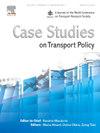Selectıng pedestrianization types for sustainable urban mobility: A case study of Trabzon, Turkey applicatıon
IF 3.3
Q3 TRANSPORTATION
引用次数: 0
Abstract
Pedestrianization studies are increasingly common, especially in urban centers. Such approaches are generally accepted as people-oriented, sustainable and economically efficient. On the other hand, the large and deep-rooted nature of the intervention may bring with it different problems. It is important to know the effects of clearing private vehicle traffic from the region. The clearing of a region from private vehicle traffic affects many features such as redirected traffic, public transportation routes, parking, spatial interaction, economic interaction, social life and accessibility. Therefore, the effects of the intervention should be measured in all its dimensions with an accurate traffic assignment and prediction, and appropriate scenarios/alternatives should be produced. In this study, an integrated pedestrianization proposal has been developed for the Kahramanmaraş Street Area in the city center of Trabzon. The most suitable alternative has been determined by carrying out a traffic assignment and developing success criteria. The effects of the selected alternative were then examined, and solution strategies were co-developed through a participatory process involving transport-related NGOs, associations representing vulnerable groups, professional chambers, and state institutions familiar with the city’s dynamics (e.g., directorate general for state hydraulic works directorate general for state hydraulic works, highways, municipalities, urban infrastructure units, the governorship, police, and transport departments). The strategies covered traffic redirection, parking access, minibus stop relocations, logistics regulations, and emergency response routes.
Selectıng可持续城市交通的步行化类型:以土耳其特拉布宗为例applicatıon
行人专用区研究越来越普遍,尤其是在城市中心。这些办法被普遍接受为以人为本、可持续和经济效率高。另一方面,干预的规模和根深蒂固的性质可能带来不同的问题。我们必须了解清除区内私家车的影响。清除一个区域的私家车会影响许多特征,如重定向交通、公共交通路线、停车、空间互动、经济互动、社会生活和可达性。因此,干预措施的影响应在所有方面进行测量,并进行准确的交通分配和预测,并提出适当的方案/替代方案。在这项研究中,为特拉布宗市中心的kahramanmaraki街道区域制定了一个综合步行化建议。通过进行交通分配和制定成功标准,确定了最合适的替代方案。然后对选定替代方案的影响进行了检查,并通过一个参与性过程共同制定了解决方案战略,该过程涉及与运输有关的非政府组织、代表弱势群体的协会、专业商会和熟悉城市动态的国家机构(例如,国家水利工程总局、国家水利工程总局、高速公路、市政当局、城市基础设施单位、州长、警察、以及交通部门)。这些战略包括交通重定向、停车通道、小巴站点搬迁、物流法规和应急响应路线。
本文章由计算机程序翻译,如有差异,请以英文原文为准。
求助全文
约1分钟内获得全文
求助全文

 求助内容:
求助内容: 应助结果提醒方式:
应助结果提醒方式:


